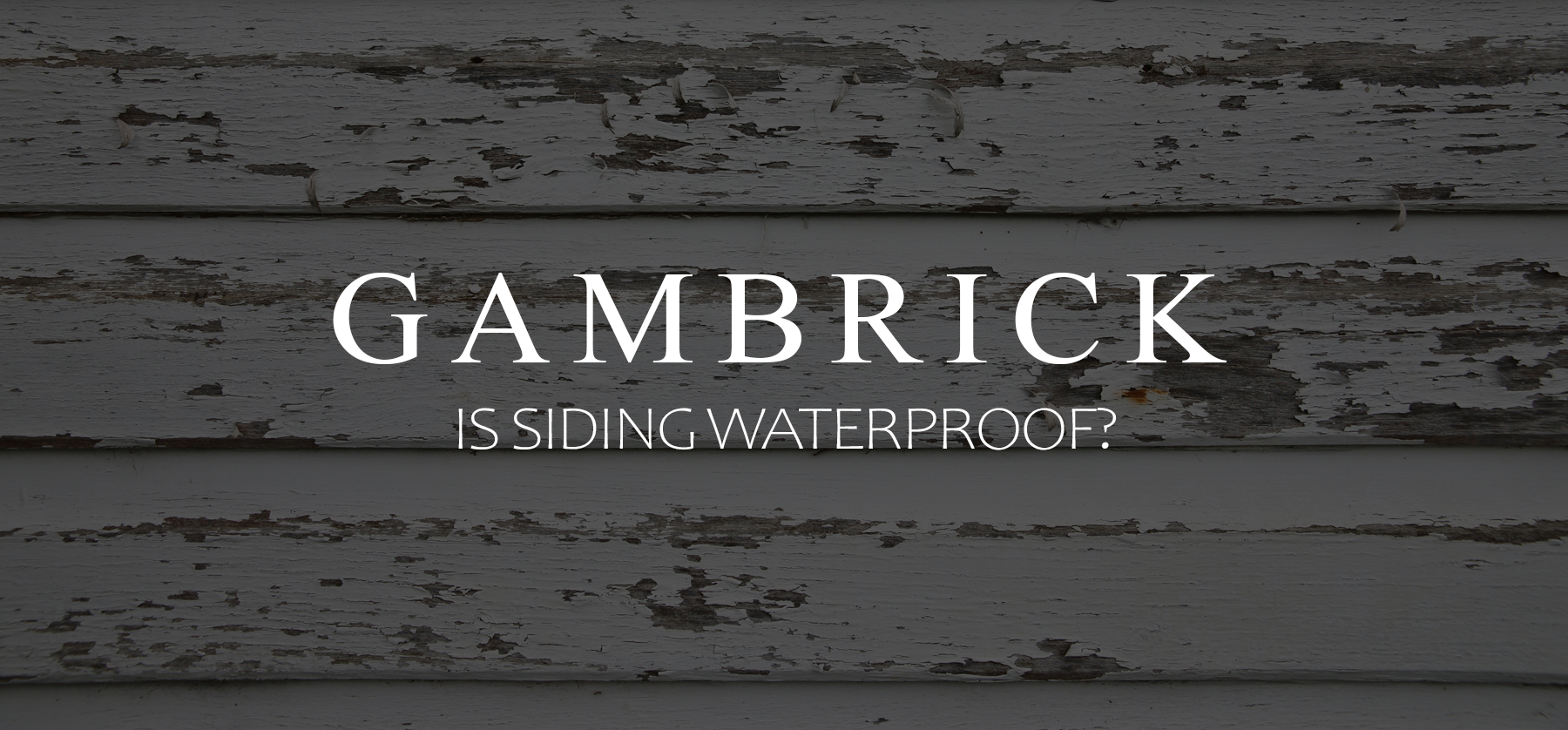Is Siding Waterproof?
Is siding waterproof? Yes and no. The siding itself can be waterproof if it’s made of a composite material. For example, vinyl siding is waterproof because it’s primarily made from plastic. But wood and fiber cement siding is not. They both absorb water and need a sealant like paint to help them resist moisture. The question should really be, does siding make your home waterproof? And the answer is no. Even vinyl siding isn’t considered waterproof when it’s installed on a house. Siding is not 100% waterproof; it’s considered water resistant.
Even a tiny gap is enough to let moisture in which can eventually damage the house. This is why other waterproofing methods are used in addition to siding. Things like caulk, flashing, sealants, tape, trim, and house wrap.
Residential and commercial properties are both prone to water damage due to penetration through the siding. Every house and building has some sort of siding, but water damage is still the number one cause of damage we see. Mold, mildew, and rot are all common issues caused by water penetrating the siding.
The question is: what keeps water out? Multiple layers of protection are the way to go.
A good quality house wrap under the siding helps protect against water damage by stopping moisture that gets behind the siding. You should also use caulk to fill small gaps, tape around windows, and use flashing and trim. Siding serves as the initial watershed, protecting the homes from damage, but it can’t do the job alone.
Even though siding is not 100% waterproof, by using multiple methods and materials to prevent water, you can stop moisture from penetrating and damaging the home. Ahead we’ll look at how.
Siding Alone Won’t Waterproof A Home
Many homeowners have a misconception that their home siding is waterproof. But that’s often not the case. Nationwide 1 in 6 homes will experience some form of water damage. If you fail to waterproof your home correctly, it will eventually show some signs of water damage. Therefore, it’s essential to waterproof your home with additional layers of protection.
Research shows that exterior home siding does not provide enough protection against water. If you take proper steps to waterproof your home, you can avoid the risk of expensive water damage.
There are many ways moisture can penetrate your siding-clad exterior. Siding often contracts and expands due to temperature fluctuations, leading to gaps that allow water to pass through. As a result, water penetrates through cracks around unsealed windows and doors.
In addition, moisture can penetrate through the overlapping ends of the siding panels. That’s why you need a good quality house wrap under the siding. And moisture that penetrate the siding layer will be blocked by the underlayment. When your installing fiber cement siding, an addition layer of flashing should be installed between each siding panel joint wherever two panels meet. This flashing goes on top of the wrap. A layered approach is always best.
It’s crucial to install water-resistant layers beneath the siding to waterproof the home. If you fail to install these additional water-resistant layers, water can get in and lead to mold growth, mildew rotting.
How To Waterproof Your Home Siding
You should always take additional steps to ensure proper protection against moisture. The key to creating a water-resistant exterior is layering. In terms of siding, this means layering flashing, house wrap, sealants, caulk, tape, siding, and trim. It’s virtually impossible to completely seal and waterproof siding without additional materials.
Siding itself is great at keeping water off the house. When water hits it, it’s directed down and away from the exterior, but even a small gap can allow water through. The roof, foundation, doors, windows, and any other breaks like vent pipes and chimneys create areas where moisture can seep in. The source can be rainfall, especially wind-blown rain which hits the house at strange angles, snow,ice, humidity, or even sprinklers placed near the home.
It only takes a small amount of water to cause damage over time. Especially if that water is not allowed to dry or persists for long periods of time. This is often hard and expensive to deal with once the house is already siding. For this reason, layering should be done from the start.
I recommend installing a waterproof system underneath your siding to protect the home against water, moisture, snow, ice, etc.
Additional Layering That Helps Siding Waterproof A Home
There’s more to siding a house than simply installing some siding. To keep water out you need multiple layers of protection. Not only does layering protect your siding, but it also safeguards your door and window openings.
The majority of waterproofing methods are basically the same regardless of what type of siding you use. However, there are a few special requirements you should take when using wood and fiber cement. We’ll be going over the general methods here.
- House Wrap. No matter what type of siding your using. Always encase the entire house with a good quality wrap.
- Wrap Tape. Tape the seams when you use house wrap.
- Sealant Tape. Use thick sealant tape around all window and door flanges.
- Caulk. Fill any gaps and cracks.
- Sealants. This includes paint, stain or sealers. Generally this is only for wood or fiber cement.
- Flashing. Always install flashing as needed. When using fiber cement flashing should be placed between each siding joint.
- Trim. A piece of trim with caulk is a great way to keep water out of doors and windows.
- Clearances. Always respect proper siding clearances. This is especially important with wood and fiber cement as they absorb water.
- Siding. Panels, shakes and trim pieces are the last layer of water defense you’ll install.
Siding is great at keeping massive amounts of water off the house. Even during a heavy rain fall, siding will divert water down and away. But damage to the home is typically caused by small amounts of water that get through over time, not large amounts which are easy to spot. To prevent water damage always use a layered approach.
House Wrap
House wrap is a major line of defense against water damage. It’s installed against the sheathing right under the siding. The first step in siding a home is installing house wrap over the entire exterior. All the other siding layers which include the siding itself, trim, caulk, flashing sealants and tape are all installed over the wrap.
A good quality house wrap is not only water resistant but also durable.
House wrap should resist tearing and maintain its integrity throughout the installation process. If your siding project will require house wrap to be exposed for more than a month, be sure it’s also resistant to UV damage which can start to deteriorate low quality paper.
Make sure to also install house wrap tape at all seams and overlaps. This helps prevent water from getting in and behind the wrap. Also install tape to cover up any tears in the wrap that can happen during installation.
House wrap tape is different that window/door sealant tape.
Once house wrap is fully and properly installed and taped the home should be temporarily water tight. However keep in mind house wrap and tape alone are not permanent solutions. Side, flash, caulk, tape and seal the house as soon as you can after the wrap is installed. I like to start siding within a week after the wrap is complete to limit potential issues.
House wrap is done after the windows and doors are installed. However, we install a layer of wrap around window and door rough openings before installing the windows and doors. This is part of the window/door installation process and further helps prevent leaks.
Flashing
Siding is designed to repel water and direct it away from the home. But there can still be small gaps, cracks and areas where siding can’t do it alone. Flashing helps seal the gaps by providing protection between the siding and other materials.
Flashing is generally a thin strip of sheet of material, usually metal, installed at junctions between exterior surfaces. For example, between where two pieces of fiber cement siding meet, flashing is installed. It’s also common around the tops of doors and windows, around chimneys and in corners.
Flashing helps to control and direct water flow. If water get behind the siding, it hits the flashing and runs down. For this reason flashing should always be installed in an overlapping stack from bottom to top. As water runs down flashing it hits the next layer of flashing or siding until it eventually hits the ground.
Flashing should be used anywhere the direction of a drainage plane changes. For example, where a deck meets the house, above windows and doors, around chimneys, etc. Corners are an excellent place to use flashing.
Keep in mind that flashing should be sized and installed correctly to be effective. Be sure it’s wide enough to prevent water from overflowing and leaking behind it. If water can penetrate or get behind the flashing then it’s of no use.
Always consider factors like wind-blown rain, snow and ice. Flashing can help protect against water in situations where siding may be compromised. For example, if you live in an area that sees heavy wind-blown rain in odd directions, some extra wide flashing can help stop water that travels upwards or sideways. It’s also great at preventing water penetration due to heavy snow piles and ice.
Caulking
Caulking seals small cracks and gaps that are hard to cover by other means. This is especially helpful with older homes where surfaces aren’t always perfect. It’s not a good idea to rely on lots of caulk to water proof but a little bit here and there can be a big help.
Because caulk is so flexible it’s great at sealing round areas where other materials have trouble. Generally siding, flashing and tapes are best for square surfaces.
It may seem like a good idea to caulk everything in an attempt to fully waterproof an area, this can be a bad thing. Caulk can shrink over time and eventually needs replacement. It’s meant for small areas not as your main method of waterproofing. Think of it as extra protection and a way to seal areas that can’t be by other means.
Siding typically has areas that allow water to drain and air to flow. These areas should not be caulked.
Water damage is very common near corners and edges or around windows and doors. Some caulk in these areas can be a big help. This also applies to trim boards and window frames. Any inconsistencies in the siding or trim, such as cracks or holes should also be caulked. I would recommend caulking any area where water can get in that you can’t side, trim or flash. And in some cases we use some caulk along side the flashing, siding and trim. It all depends on the project.
Caulking should not be applied to weep holes or the bottom of siding as these areas are meant to drain water.
Use caulk sparingly. It’s best for a little extra protection here and there, not as a primary means of waterproofing.
Trim
Another great way to make siding waterproof is adding trim around the windows. Trim is completely solid other than the corner joints and those can be sealed with some glue and caulk. You can also run a bead of silicone caulk behind the trim and around the edges where you don’t see because it’ll be covered by siding. With all this extra protection it becomes even harder for water to penetrate into the windows. Which is a common issue.
Pair window trim with a little bit of flashing on top. This is commonly called drip flashing. It prevents water from accumulating above the window and dripping inside. By combining trim, flashing, siding and a bit of caulk, you can waterproof those windows and doors.
The width of the trim, material and style can vary based on the style and size of the home.Here are a few guidelines.
- Larger homes typically have bigger windows which allow for fatter trim. Go too fat on a small window and it gets overwhelming.
- Thin trim is great for Modern style homes with a minimalist look.
- If you want to stay maintenance free then opt for composite materials like Azek. But I like traditional materials and the look of real wood.
- Fiber cement is another great option but like wood it needs some paint or stain.
- Wrap wood with sheet metal for a budget option.
Another option is simply wrapping the windows with J-channel before you side. It’s a cheap option with a minimalist look but doesn’t help water proof the siding.
Sealants
Certain types of siding need additional sealants to be more waterproof because they’re not naturally water resistant. A sealant adds another layer of protection that sits atop the siding and helps repel water. Some sealers are applied at the factory and some on site. I prefer to do it on site because it allows me to put sealer in all the little cracks and crevices. Doing it myself also gives me more control over the amount I put on and the number of coats I use.
Sealants not only protect the house by sealing small cracks and gaps but it also protects the siding itself from water damage and weathering.
- Wood. Some types of wood siding need an additional sealant because they weather excessively. Pine siding, for example, wouldn’t last very long outdoors and wouldn’t resist water for long if it wasn’t sealed after installation. Sealants that work well on wood include, paint, stain and simple sealers. Some types of wood, like cedar, don’t need a sealer because cedar is naturally weather resistant and ages well. One thing all types of wood have in common is that they grey over time without a sealant. If you want your cedar to maintain it’s rich color then you’ll need to seal it as needed.
- Fiber Cement. Fiber cement siding is great at resisting water but it absorbs moisture like a sponge. This is why there’s special flashing and clearance instructions that need to be followed when you install it. If you don’t and the siding absorbs water you could void the warranty. Some paint or stain helps fiber cement stay dry by sealing it tight.
- Vinyl. Any type of composite siding is naturally waterproof all on it’s own so you don;t need an additional sealant.
Sealant Tape
Thick sealant tape should be installed around all your windows and doors prior to trim, flashing, siding and caulk but after the house wrap. It’s sticky so there’s no need for any staples or nails. However, if you don’t side within a few weeks the tape can start to peel off. It’s hold gets weaker when exposed to sun and rain.
Try to install sealant tape when it’s warm outside. When it’s too cold the glue isn’t sticky enough to adhere to the house and you’ll need to use staples. I like to avoid puncturing the tape as much as possible because every small hole becomes a place water can penetrate.
Here are the basic steps.
- Wrap the windows opening with house wrap.
- Install the windows and doors.
- Cover the entire house with house wrap including taping all seams with wrap tape.
- Install thick sealant tape over all window and door flanges.
The minimum width we use is 4″ but I like the thicker 6″ tape. It provides just a little more protection and extends beyond the standard 4″ window trim.
When installing sealant tape start from the bottom of the window or door and work your way up. Layer the tape so that the top piece sits on top of the side pieces. By doing this water will run down the tape and drain. If you layer the tape improperly water could get behind which renders the tape useless.
Final Words
Research shows that even the most effective siding installation is not 100% waterproof. That’s why experts recommend installing a complete waterproofing system to protect your home from harsh weather conditions. This includes multiple materials layered on top of one another to add redundancy and fill any small gaps or cracks.
Even though siding on it’s own is not 100% waterproof, you can still protect your home from water damage.
Summary: Is Siding Waterproof?
Is siding waterproof? Yes and no. The siding itself can be waterproof if it’s made of a composite material. For example, vinyl siding is waterproof because it’s primarily made from plastic. But wood and fiber cement siding is not. They both absorb water and need a sealant like paint to help them resist moisture. The question should really be, does siding make your home waterproof? And the answer is no. Even vinyl siding isn’t considered waterproof when it’s installed on a house. Siding is not 100% waterproof; it’s considered water resistant.
- Even a tiny gap is enough to let moisture in which can eventually damage the house. This is why other waterproofing methods are used in addition to siding. Things like caulk, flashing, sealants, tape, trim, and house wrap.
- Residential and commercial properties are both prone to water damage due to penetration through the siding.
- Every house and building has some sort of siding, but water damage is still the number one cause of damage we see.
- Mold, mildew, and rot are all common issues caused by water penetrating the siding.
The question is: what keeps water out? Multiple layers of protection are the way to go. A good quality house wrap under the siding helps protect against water damage by stopping moisture that gets behind the siding. You should also use caulk to fill small gaps, tape around windows, and use flashing and trim. Siding serves as the initial watershed, protecting the homes from damage, but it can’t do the job alone.
Even though siding is not 100% waterproof, by using multiple methods and materials to prevent water, you can stop moisture from penetrating and damaging the home. Ahead we’ll look at how.
If you have any questions or comments about siding E-mail any time.





















